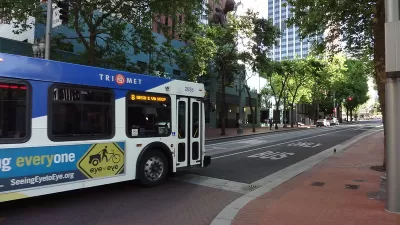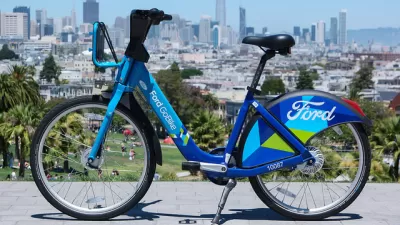Bus lanes along a primary transit corridor have sped up travel times and point to the potential for major citywide improvements.

Alon Levy takes a closer look at the outcomes of a San Francisco project that includes dedicated bus lanes on Mission Street, an arterial with one of the highest transit ridership levels in the city and lots of congestion.
Buses running along the 2.5-mile section are moving two minutes faster, and Muni expects this to increase to five minutes when the project upgrades are complete. "The two minutes of saved travel time represent about 10% of current trip time, and the projected five-minute saving is a quarter of the total travel time," says Levy.
He notes that the program also includes left turn restrictions and forced right turns, which have resulted in decreased traffic on Mission Street. Bus stops along the route were also consolidated to help with travel times.
Levy says that the program so far looks like a complete success and should be replicated in other parts of the city:
City residents who travel to areas not served by BART or by the Muni Metro tunnel would be able to count on buses being there; people who can afford Uber or Lyft might choose to stay on the cheaper bus nonetheless, and people who cannot might still choose to make more trips by bus, creating a virtuous cycle of more ridership and more service.
He argues that in the long run these improvements would help transit riders but could also substantially transform San Francisco’s larger transportation network.
FULL STORY: Mission Bus Lanes Work Wonders For Riders - Pedestrian Observations

Alabama: Trump Terminates Settlements for Black Communities Harmed By Raw Sewage
Trump deemed the landmark civil rights agreement “illegal DEI and environmental justice policy.”

Study: Maui’s Plan to Convert Vacation Rentals to Long-Term Housing Could Cause Nearly $1 Billion Economic Loss
The plan would reduce visitor accommodation by 25% resulting in 1,900 jobs lost.

Planetizen Federal Action Tracker
A weekly monitor of how Trump’s orders and actions are impacting planners and planning in America.

Waymo Gets Permission to Map SF’s Market Street
If allowed to operate on the traffic-restricted street, Waymo’s autonomous taxis would have a leg up over ride-hailing competitors — and counter the city’s efforts to grow bike and pedestrian on the thoroughfare.

Parklet Symposium Highlights the Success of Shared Spaces
Parklets got a boost during the Covid-19 pandemic, when the concept was translated to outdoor dining programs that offered restaurants a lifeline during the shutdown.

Federal Homelessness Agency Places Entire Staff on Leave
The U.S. Interagency Council on Homelessness is the only federal agency dedicated to preventing and ending homelessness.
Urban Design for Planners 1: Software Tools
This six-course series explores essential urban design concepts using open source software and equips planners with the tools they need to participate fully in the urban design process.
Planning for Universal Design
Learn the tools for implementing Universal Design in planning regulations.
Caltrans
Smith Gee Studio
Institute for Housing and Urban Development Studies (IHS)
City of Grandview
Harvard GSD Executive Education
Toledo-Lucas County Plan Commissions
Salt Lake City
NYU Wagner Graduate School of Public Service





























